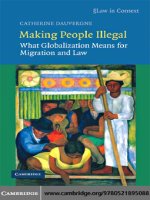cambridge university press bioviolence preventing biological terror and crime sep 2007 kho tài liệu bách khoa
Bạn đang xem bản rút gọn của tài liệu. Xem và tải ngay bản đầy đủ của tài liệu tại đây (2.81 MB, 392 trang )
P1: KNP
9780521883252pre
CUFX174/Kellman
978 0 521 88325 2
September 6, 2007
This page intentionally left blank
ii
18:15
P1: KNP
9780521883252pre
CUFX174/Kellman
978 0 521 88325 2
September 6, 2007
BIOVIOLENCE: PREVENTING BIOLOGICAL TERROR
AND CRIME
Bioviolence is the hostile infliction of disease. Terrorists or criminals could
use disease to cause catastrophic consequences and panic, making everyone
vulnerable. Too little is being done to prevent bioviolence, and accelerating
advances of bioscience open new threat potential. While bio-offenders are
becoming more focused and organized, prevention policies are vague, gapridden, and unsupervised. No other threat presents such severe danger yet
such a failure of leadership to reduce risks. This book explores how global governance should evolve to address bioviolence challenges. Law enforcers, scientists, and public health officials should coordinate their prevention efforts.
Nations and international organizations, especially the United Nations, need
to cooperatively improve humanity’s security. Altogether, the strategy for preventing bioviolence requires a global covenant to promote bioscience while
understanding its inherent and unavoidable dangers.
Barry Kellman is professor of international law and Director of the International Weapons Control Center at DePaul University College of Law. He is Special Advisor to the Interpol Program on Prevention of Bio-Crimes and senior
chair of the American Bar Association Committee on International Law and
Security. Professor Kellman served on the National Academies of Sciences
Committee on Research Standards and Practices to Prevent the Destructive
Application of Biotechnology (2003). He was Legal Advisor to the National
Commission on Terrorism and was later commissioned by the Memorial Institute for the Prevention of Terrorism (MIPT) to draft Managing Terrorism’s Consequences, which reviews legal authorities for responding to terrorism in the
United States. He has published widely on weapons proliferation and smuggling, the laws of armed conflict, Middle East arms control, and nuclear nonproliferation.
i
18:15
P1: KNP
9780521883252pre
CUFX174/Kellman
978 0 521 88325 2
September 6, 2007
ii
18:15
P1: KNP
9780521883252pre
CUFX174/Kellman
978 0 521 88325 2
September 6, 2007
BIOVIOLENCE
Preventing Biological Terror
and Crime
BARRY KELLMAN
DePaul University College of Law
iii
18:15
CAMBRIDGE UNIVERSITY PRESS
Cambridge, New York, Melbourne, Madrid, Cape Town, Singapore, São Paulo
Cambridge University Press
The Edinburgh Building, Cambridge CB2 8RU, UK
Published in the United States of America by Cambridge University Press, New York
www.cambridge.org
Information on this title: www.cambridge.org/9780521883252
© Barry Kellman 2007
This publication is in copyright. Subject to statutory exception and to the provision of
relevant collective licensing agreements, no reproduction of any part may take place
without the written permission of Cambridge University Press.
First published in print format 2007
eBook (EBL)
ISBN-13 978-0-511-34163-2
ISBN-10 0-511-34163-6
eBook (EBL)
ISBN-13
ISBN-10
hardback
978-0-521-88325-2
hardback
0-521-88325-3
ISBN-13
ISBN-10
paperback
978-0-521-70969-9
paperback
0-521-70969-5
Cambridge University Press has no responsibility for the persistence or accuracy of urls
for external or third-party internet websites referred to in this publication, and does not
guarantee that any content on such websites is, or will remain, accurate or appropriate.
P1: KNP
9780521883252pre
CUFX174/Kellman
978 0 521 88325 2
For
Aly, Bobby, and Shannon
and Theirs and Theirs and Theirs
May This Book’s Fears Prove Illusory
v
September 6, 2007
18:15
P1: KNP
9780521883252pre
CUFX174/Kellman
978 0 521 88325 2
September 6, 2007
vi
18:15
P1: KNP
9780521883252pre
CUFX174/Kellman
978 0 521 88325 2
September 6, 2007
Contents
Prologue
Foreword, by Ronald K. Noble, Interpol Secretary General
Acknowledgments
page xiii
xvii
xxvii
Introduction . . . . . . . . . . . . . . . . . . . . . . . . . . . . . . . . . . . . 1
The Bioviolence Policy Failure
Thematic Foundations
Three Crossroads
Law for Humanity
Terminology
Presentation of the Argument
2
3
3
4
5
7
PART I. THE BIOVIOLENCE CONDITION AND HOW IT
CAME TO BE
1
Why Worry? . . . . . . . . . . . . . . . . . . . . . . . . . . . . . . . . . 11
Why Bioviolence Is Different
Delayed Anonymity
Concealable Devastation
Contagious Panic!!!
Evaluating Risks
2
11
12
15
17
18
Methods of Bioviolence . . . . . . . . . . . . . . . . . . . . . . . . . 20
Interwoven Choices
Smallpox
Eradication?
The Challenge: Getting the Virus
21
24
24
25
vii
18:15
P1: KNP
9780521883252pre
viii
CUFX174/Kellman
978 0 521 88325 2
September 6, 2007
CONTENTS
Influenza and Hemorrhagic Fevers
Influenza
Reasons for Concern
Limits of Protection
Hemorrhagic Fever Viruses
Acquiring the Agent: Initiating the Attack
Disseminating the Virus
Anthrax
Getting and Cultivating Seed Stock
Disseminating the Agent
Botulinum in Food
Agroviolence
Motivations and Feasibility
Attacks of Grave Concern
Livestock Diseases
Crop Diseases
International Prevention Systems
Agents Historically Used as Bioweapons
Plague
Tularemia
Q Fever
Ricin
Emerging Micro-Sciences and Bioviolence
Molecular Biology’s Emerging Risk
Modification of Weapons Agents
Improving Target Specificity
Synthetic Genomics
Re-Creation of Diseases
Synthetic Viruses
RNA Inhibitors and Bioregulators
Nanotechnologies
3
28
28
28
29
31
31
32
33
35
36
38
40
41
42
42
43
44
45
45
46
47
47
47
49
49
51
51
51
52
52
53
Who Did Bioviolence? Who Wants to Do It? . . . . . . . . . . . . . 55
The Biological Weapons Experience
The Road to Geneva
Mid-20th -Century Bioweapons Programs
Unit 731
The U.S. Offensive Bioweapons Program
The Soviet Biological Weapons Program
Iraq’s Biological Weapons Program
55
56
56
57
57
59
61
18:15
P1: KNP
9780521883252pre
CUFX174/Kellman
978 0 521 88325 2
September 6, 2007
ix
CONTENTS
South Africa’s Project Coast
Egypt
Israel
Current (Alleged) State Biological Weapons Programs
Questions about Military Efficacy
Suspected State Bioweapons Programs
North Korea
Iran
Syria
Terrorist and Fanatic Interest in Bioviolence
Islamic Fundamentalist Interest in Bioviolence
Al Qaeda’s Intentions
Religious and “Legal” Justification
Acquisition of Agents and Expertise
Production
Concluding Observations
63
64
65
66
67
68
69
70
71
71
72
73
74
77
78
82
PART II. THE GLOBAL STRATEGY FOR PREVENTING
BIOVIOLENCE
4
Strategic Foundations . . . . . . . . . . . . . . . . . . . . . . . . . . 87
The Indictment
Obstacles to Policy Progress
Bioviolence Is a Crime!
Overview of the Prevention Strategy
Complication
Resistance
Preparedness
Nonproliferation
Guiding Principles
5
88
92
94
95
96
96
97
98
98
Complication: What Law Enforcers Should Stop . . . . . . . . . 101
Irresponsible Gaps
The Logic of Complication
Denial + Interdiction
Bioscience’s Anxieties
Registration and Census
Denial Tactics
Denying Access to Pathogens
Pathogen Census
102
103
104
105
108
109
109
111
18:15
P1: KNP
9780521883252pre
x
CUFX174/Kellman
978 0 521 88325 2
September 6, 2007
CONTENTS
Pathogen Marking
Denying Access to Laboratories
Denying Access to Equipment
Interdiction
Legislating the Crime
The Dilemma of Pre-Attack Interdiction
Clues of Bioviolence
Pattern Recognition
Transport Security and Counter-Smuggling
Packaging and Labeling
Shipping Security
Intrusive Counter-Smuggling
6
Improving Resistance through Science . . . . . . . . . . . . . . . 132
Dual-Implication Research
The Challenge of Overseeing Bioresearch
Constraining Science?
Virtues and Limitations of Codes of Ethics and
Self-Regulation
The Need for Translucency
Bioscientists as the First Line of Defense
Bioresearch Education and Training
Professional Certification
Whistleblowers
Development of Vaccines and Medicines
Financial Barriers
Liability Barriers
Patent Barriers
7
111
112
114
116
117
118
119
121
124
126
127
129
133
134
137
139
142
144
144
145
146
147
149
152
155
Public Health Preparedness . . . . . . . . . . . . . . . . . . . . . . 160
Preparedness vs. Complication – The False Debate
Hardening Targets
Protecting Air Circulation Systems
Protecting Water Supplies
Sensors
Response Interventions
Detecting and Analyzing a Bioviolence Attack
Law Enforcement – Public Health Cooperation
Biosurveillance
Microbial Forensics
161
164
165
165
166
168
169
171
171
172
18:15
P1: KNP
9780521883252pre
CUFX174/Kellman
978 0 521 88325 2
September 6, 2007
xi
CONTENTS
Containing Contagion
Compulsory Vaccination for First Responders
Placement of Victims
Stockpiling and Distribution of Medical Resources
Compulsory Medical Interventions
Maintaining Public Confidence
Quarantines
Considerations of a Quarantine’s Efficacy
Quarantines and the World Health Organization’s
Authority
8
188
International Nonproliferation . . . . . . . . . . . . . . . . . . . . 192
Defining Biological Weapons
The General Purpose Criterion
“Nonlethal” Bioagents
Arguments For and Against Nonlethal Bioagents
Types of NLBAs
U.S. Military Nonlethal Programs
Implications for the Biological Weapons Convention
Compliance, Verification, and Confidence Building
The Biodefense Dilemma
The Problem of Secrecy Reprised
Biodefense Projects of Concern
Strengthening Confidence
Disarming Soviet Bioweapons Stockpiles
Two Issues for Removal
Protecting the Free Trade in Bioscience
A Global BWC Organization
9
173
175
178
179
181
184
185
186
196
196
197
198
200
202
204
205
207
209
211
213
215
219
220
221
The Challenge of Global Governance . . . . . . . . . . . . . . . . 222
Governance Mission: The Global Covenant
Governance Agencies
The United Nations Commission on Bioscience and
Security (Commission)
Promote Bioscience Research
Define Standards for Bioscience
Promote Capacity Building and Resource Mobilization
The Bioviolence Prevention Office (Office)
Information Gathering and Analysis
Impelling Implementation
222
226
228
228
230
231
233
234
235
18:15
P1: KNP
9780521883252pre
xii
CUFX174/Kellman
978 0 521 88325 2
September 6, 2007
CONTENTS
United Nations Bioviolence Committee (Security Council
Committee)
Predecessors
A New Inspectorate
A Final Note on Governance
238
239
240
241
Conclusion . . . . . . . . . . . . . . . . . . . . . . . . . . . . . . . . . . . 242
Notes
247
Bibliography
285
Index
355
18:15
P1: KNP
9780521883252pre
CUFX174/Kellman
978 0 521 88325 2
September 6, 2007
Prologue
As this book is written, civil war and insurgency inflame Iraq; Palestinians and Israelis unrelentingly clash; and genocide perpetuates in Darfur.
With time, other and perhaps worse conflicts will come to the fore. Eventually, some combatant or fanatic will choose to raise the stakes by using
a weapon that altogether multiplies casualties. Just as planes flying into
towers on 9/11 instantly became an historical marker dividing strategic
perspectives before from after, that day will herald the onslaught of disease as an instrument of malevolence, profoundly changing everything.
Today, leaders proclaim that they are doing everything possible to meet
this threat. Following a truly catastrophic act of bioviolence, they will likely
tell the public that they had no idea where, when, or how a bioattack would
occur – if they had known, they would of course have dedicated all their
prodigious powers to thwart it. And the evil perpetrators of this horrible
crime surely will be caught and punished.
These proclamations are disingenuous and these avowals will be halftruths, deluding all of us about where security may be found and how to get
there – not so much a deliberate lie but a mirage grounded on little more
than a wish and a prayer. The more complete truth is that little is being
done to prevent bioviolence; if catastrophe occurs, leaders must be held
responsible for willful disregard of the well-being of countless victims who
entrust them to prevent unspeakable horrors. There is no way to know
where, when, or how a bioattack will occur, but much can be learned if
we gather information more effectively. A promise to hold the attackers
to account is a small gesture: most likely they will be dead or very hard
to find; in any event, punishing them will scarcely compensate for the
massive injuries inflicted.
This book is in small part an indictment, in larger part a policy map.
More broadly, it is a discussion of how international law should cope with
xiii
18:15
P1: KNP
9780521883252pre
xiv
CUFX174/Kellman
978 0 521 88325 2
September 6, 2007
PROLOGUE
the planetary implications of advancing bioscience. It is born of seven years
of traversing five continents and participating in hundreds of workshops,
meetings, and briefings with officials of governments and international
organizations, scientists, diplomats, and advocates of peace and development. Emerging from this experience is a strong belief that humanity is
more vulnerable than it should be and that the dangers are speedily and
unnecessarily accelerating.
The central reality of bioviolence is that it is an immense threat, but a
massive catastrophe has not yet happened. Few informed policy makers
are sanguine about this threat, but it is at the periphery of their vision,
superseded by more urgent crises. Without a bioattack that reveals the
failure of current policies, support for progressive initiatives is difficult to
rouse. Truth is, we are likely to take appropriate steps to prevent a second
bioattack, but we seem fated to suffer the wounds of one disease disaster
before this conjectural threat becomes real enough to embrace complex
policies. Frustrating as this realization might be, it exposes the dilemma
of how to make tough choices in uncharted policy arenas at the frontiers
of science and law.
Ultimately, placing blame would be pointless. It is important to know
why decisions have been unwise, and readers are entitled to be discouraged by our leaders’ disarray in addressing bioviolence. Yet, the analytical
challenges associated with preventing bioviolence are difficult to resolve.
The threat is a multifaceted phenomenon; each facet reflects angles and
depths that intersect with ever more far-reaching implications. At the heart
of this difficulty is how to grapple with a problem that necessarily demands
humanity-wide cooperation in the context of fragmented and anarchic
political systems.
A pervasive question is whether the sweeping changes called for in
this book are “worth it.” Does the level of risk justify the cost of globally implementing expensive intrusions into scientific freedom, national
sovereignty, and personal privacy? Many policies must be pursued with
potentially adverse ramifications for professional and scientific communities that are key to addressing bioviolence. And underlying this question
is the wish that anxiety about bioviolence turns out to be a false alarm –
hopefully much ado about something that never occurs.
What is certain is that trend lines are pointing the wrong way. Technological progress increasingly enables a mere handful of maniacs to commit
a monstrous level of violence. Until recently, only a powerful nation-state
could threaten such devastation. Whatever their motives – greed, distorted
sense of political grievance, nihilism – a nano-fraction of humanity can
18:15
P1: KNP
9780521883252pre
CUFX174/Kellman
978 0 521 88325 2
September 6, 2007
xv
PROLOGUE
now inflict a species-wide catastrophe that breaches the progression of
history. At the beginning of the third millennium, bioviolence scenarios
that crack the foundations of modern civilization’s stability are the most
likely deliberate threat to humanity’s survival and progress.
How these risks should be measured, what they justify in terms of
commitment of resources and insistence on change – these are questions
that deserve serious discussion. Currently, that discussion is impaired by
inadequate systematic analyses of relevant issues. Absent breadth of perspective, threats of bioviolence are met with planetary silence. This book
is a refusal to perpetuate that silence.
We can make the world a lot safer, save some children from dying
whether by hand of nature or man, and, most intriguing, we can appreciate
the role of law in shaping human affairs at this time.
Barry Kellman
Chicago, USA
18:15
P1: KNP
9780521883252pre
CUFX174/Kellman
978 0 521 88325 2
September 6, 2007
xvi
18:15
P1: KNP
9780521883252pre
CUFX174/Kellman
978 0 521 88325 2
September 6, 2007
Foreword
Ronald K. Noble
Secretary General, Interpol
Throughout the centuries, diseases unleashed by nature have savaged
humankind on a horrific scale, inflicting wide-scale death, as well as social,
political, and economic upheaval. In the 20th Century alone, more people
died of smallpox (over three hundred million) than in both world wars combined, and an influenza epidemic claimed over forty million lives. Even
a disease that afflicts only animals can have devastating consequences.
The outbreak of foot and mouth disease in the United Kingdom in 2001
took months to control, required the slaughter of millions of animals, and
caused billions of dollars in losses.
These are the risks posed by nature. Now, added to these risks, we face
the threat of bioterrorism.
We know from recent events that terrorists remain committed to perpetrating large-scale violence. And we also know that there is much evidence
that terrorists have a strong interest in the use of biological weapons and
are planning to use them. The eleventh volume of Al Qaeda’s Encyclopedia
of Jihad is devoted to chemical and biological weapons. Captured terrorist
suspects have admitted that their organizations are plotting potential biological attacks. Authorities have seized documents, computer hard drives,
and terrorist training materials that discuss the acquisition, production,
and use of bioweapons.
We also know that, as biotechnology industries continue to expand
throughout the world, new pathogens and pathogen-making technologies
are rapidly proliferating, increasing the risk that terrorists could get their
hands on deadly pathogens or on the means of producing them. And many
experts believe that advances in biotechnology could produce genetically
engineered pathogens more lethal than any currently known to man.
There are many ways for terrorists to obtain deadly pathogens. They
can buy or steal them from universities, research labs, pharmaceutical
xvii
18:15
P1: KNP
9780521883252pre
xviii
CUFX174/Kellman
978 0 521 88325 2
September 6, 2007
FOREWORD
companies, military stockpiles, or commercial supply houses; acquire
them from “friendly states” or other sympathizers; buy them on the black
market; or produce the agents on their own.
It is also becoming ever more possible for terrorists to themselves produce the pathogens, as the volume and sophistication of the necessary
information becomes increasingly accessible through publications, the
internet, and other sources.
Once terrorists get their hands on the pathogens, they can all too easily determine how to use them in a biological attack. The information
and materials for creating biological weapons – both crude and sophisticated – are publicly available. They could even cause a so-called “martyr”
to become infected and act as a suicide bioweapon. Or they could simply
adopt the approach used by the anthrax terrorists in 2001 in the United
States, who disrupted the world’s economy by targeting and murdering
nearly ten U.S. citizens merely by placing powder laced with anthrax in
envelopes mailed to just a handful of people.
In my view, Al Qaeda’s global network, its proven capabilities, its deadly
history, its desire to do the unthinkable, and the evidence collected about
its bioterrorist ambitions and plans ominously portend a clear and present
danger of the highest order that Al Qaeda (or another terrorist group) will
someday perpetrate a biological terrorist attack.
As was made clear in a letter dated December 1, 2003, addressed to
the president of the United Nations Security Council from the chairman
of the United Nations Security Council Committee established pursuant
to Resolution 1267 concerning Al Qaeda and the Taliban and associated
individuals and entities, “Undoubtedly Al Qaeda is still considering the use
of chemical or biological weapons to perpetrate its terrorist actions. When
might this happen? Nobody really knows. It is just a matter of time before
the terrorists believe they are ready. They have already taken the decision
to use such chemical and biological weapons in their forthcoming attacks.
The only restraint they are facing is the technical complexity of operating
them properly and effectively.”
To be sure, there are some technical and other obstacles involved in
obtaining pathogens and effectively deploying them on a mass scale in the
real world, but as we learned on September 11, 2001, where there’s a will
there’s a way.
Now, I realize that my statement that the bioterrorist threat is real goes
against the natural human tendency to operate under the assumption that
terrorists will not use biological weapons in the future on a large scale because they have not done so in the past. But this assumption is dangerous.
18:15
P1: KNP
9780521883252pre
CUFX174/Kellman
978 0 521 88325 2
September 6, 2007
FOREWORD
Some would prefer not to think about the possibility of such deadly
terrorist acts. Yet, we cannot avoid the danger by ignoring it. Both the
assumption that it won’t happen because it hasn’t happened and the tendency to want to avoid a danger by not thinking about it are irresponsible.
Moreover, whatever the history, the current threat is real. Indeed, no
one ever crashed commercial airplanes into buildings before September 11, 2001, and, yet, as we learned, that threat was nevertheless all too
real.
Given the magnitude of the harm that would be caused by a bioterrorist
attack – hundreds, thousands, and even millions of deaths are possible –
it is clear to me that this alone mandates that we take this threat seriously.
Even if hundreds or thousands do not die, the panic and the social and
economic upheaval that could follow such an attack represent another
set of reasons why we should take this threat seriously. Unfortunately,
however, the world is not taking this threat seriously, and this represents a
very grave situation.
There is a lack of awareness and understanding of the threat, lack of the
required specialized training, lack of required specialized resources, lack
of the required legal and regulatory framework, and lack of the required
coordination mechanisms for the most effective prevention and response.
Because governments and their law enforcement agencies have limited experience dealing with bioterrorism, it remains a remote and esoteric
topic understood by few officials, given little attention by policy makers,
and perceived by the political leadership as having little domestic impact.
Political support and funding for security programs tend to be oriented
toward the traditional and concrete areas of crime that affect citizens on
a daily basis, such as robbery, rape, murder, and so on. There is a natural
tendency for governments to neglect threats of future harm in favor of the
seemingly more pressing matters of the day with which they are more comfortable in dealing, but this is putting the world’s citizens at great risk. The
world must start paying much more attention to the threat of bioterrorism.
Pretending that this threat does not exist is a recipe for disaster.
THE ACTIONS REQUIRED TO MEET THIS THREAT
Meeting the threat of bioterrorism requires capabilities in the following
four areas: 1) threat assessment, 2) attack prevention, 3) attack detection,
and 4) attack response (mitigating the damage, apprehending the perpetrators, and gaining knowledge and expertise to enhance future capabilities in these four areas).
xix
18:15
P1: KNP
9780521883252pre
xx
CUFX174/Kellman
978 0 521 88325 2
September 6, 2007
FOREWORD
Threat assessment is required to shape and guide the other three areas.
Attack prevention includes tactical intelligence, interdiction, disruption,
facilities protection, pathogen control, etc. Attack detection means being
able to detect a biological attack as early as possible (many pathogens
have incubation periods ranging up to a week or more before symptoms
appear, and even then it can take time to realize that they are the product
of an attack). Early detection is critical to save the injured, contain the disease, and apprehend the perpetrators before they can attack again. Attack
response includes medical services, containment, security, environmental remediation, investigation, apprehension, intelligence gathering, and
learning.
To accomplish these things, the relevant constituencies must develop
or acquire the requisite skilled personnel, tools, and equipment. They must
also establish and implement protocols and procedures to share information and cooperate in prevention and detection efforts, to mobilize
response resources in the event of an attack, and to coordinate all of these
efforts and resources (within and across functions, agencies, levels of government, and internationally).
Written plans should be created covering the conceivable potentialities
(e.g., mass decontamination, medical supply distribution, isolation, evacuation, quarantine, compulsory medical exams and vaccinations, security
for health care sites and shipments, etc.). Personnel should be trained and
equipped to execute the plans, and the plans should be exercised through
periodic drills.
Benchmarking and best practices should be developed and shared
to guide the design, exercise, implementation, and revision of plans,
protocols, and procedures. Measurable standards and metrics must be
developed to promote and determine accountability, performance, and
progress.
The relevant constituencies include police, customs, immigration,
intelligence, bioscientists, health care professionals, emergency management, military/security organizations, environmental management, agriculture, and other relevant private and public resources (local, regional,
national, and international).
Broadly speaking, however, the principal relevant constituencies are
the law enforcement, bioscience, and public health communities. These
three communities must work together nationally and internationally to
analyze the relevant threats that each sees in order to help society enhance
the likelihood of preventing a bioterrorist attack and of minimizing the
damage if such an attack occurs. Unfortunately, the law enforcement,
18:15
P1: KNP
9780521883252pre
CUFX174/Kellman
978 0 521 88325 2
September 6, 2007
FOREWORD
bioscience, and public health communities have very limited history of
working together nationally in most countries, even less so internationally.
These three communities must forge partnerships in order to ensure
an integrated approach. This is required to maximize the synergies of their
complementary skills, methodologies, perspectives, and resources, and to
minimize their conflicts (e.g., in the collection, transport, and analysis of
evidence so as to best serve medical, epidemiological, intelligence, and law
enforcement purposes). This means overcoming many formidable obstacles (security clearance, patient privacy, cultural divides, etc.), but it is
essential to do so.
Each agency has its own deeply embedded culture, and, generally
speaking, is highly resistant to change, even in times of crisis. Each agency
responds with its own routines, its own distinctive view of “the threat,” and
its own understanding of its particular mission. Although it is beneficial
for each agency to pursue its own mission, and with the methods that are
uniquely suited to that mission, it is also important to integrate these missions and methods across agencies. This type of coordination is difficult
even among agencies that are all within the law enforcement community.
It is dramatically more so when the agencies are in different professional
communities. This is why it is so challenging to achieve effective collaboration between law enforcement, bioscience, and public health agencies.
Undergirding all of the above is the need to modify legal and regulatory
frameworks to support the necessary activities. This means 1) the frameworks for controlling the manufacture, possession, storage, transportation, use, trafficking, and deployment of pathogens, and their means of
production, weaponization, and delivery; 2) the frameworks for thwarting
attacks before they occur (e.g., intelligence, investigation, interdiction, and
disruption); 3) the frameworks relating to the protection of the points of
possible pathogen intrusion (e.g., those relating to water supplies and the
food chain); 4) the frameworks relating to activities aimed at early detection of attacks that do occur (e.g., so-called medical surveillance systems);
and 5) the frameworks governing the activities required for attack response
(isolation, quarantine, forced medical exams, forced vaccinations, investigation, etc.).
All of the above-described required actions should be done on the
local, national, regional, and international levels. The inherent nature of
this threat is global. International coordination is therefore essential. For
example, national and international Incident Response Teams specialized in bioterrorism should be assembled for rapid deployment whenever
xxi
18:15
P1: KNP
9780521883252pre
xxii
CUFX174/Kellman
978 0 521 88325 2
September 6, 2007
FOREWORD
and wherever a major incident occurs. Ultimately, to address the threat of
bioterrorism, international cooperation must be strengthened. Achieving
this is a central part of Interpol’s mission.
WHAT INTERPOL IS DOING
In order to understand Interpol’s role in the international effort to prevent
and respond to bioterrorism, one must understand what Interpol is today.
Interpol is the world’s largest international law enforcement organization,
linking together essentially all of the world’s law enforcement agencies
(covering 186 member countries). It has been around since 1923, but it is
virtually all new.
Interpol has reorganized itself around three core functions. The first
core function is to maintain the world’s first secure global law enforcement
communication system. This system, called I-24/7, was created by Interpol
in 2001, and it now allows law enforcement agencies around the world to
exchange information in real time, and to have instant access to Interpol
databases and notices.
The second core function is to further develop Interpol databases (such
as our database of wanted and suspected terrorists and other international criminals, stolen passports, fingerprints, and DNA) and international notices (which serve to alert global law enforcement of fugitives, suspected terrorists, dangerous criminals, missing persons, weapons threats,
and unidentified dead bodies, and, in the case of the Red Notice, to request
the arrest of a wanted person anywhere in the world). These databases and
notices represent powerful tools in the fight against terrorism and other
serious international crime, and their contents, usage, and results have
been soaring in recent years.
The third core function is to provide operational police support services to Interpol’s National Central Bureaus and member countries’ law
enforcement agencies wherever and whenever it is needed. This means
access to Interpol experts who are available to aid police agencies in specific investigations. It also means access to Interpol’s Command and Coordination Centre, which operates around the clock in all of Interpol’s four
official languages (English, French, Spanish, and Arabic) and serves as the
first point of contact for any member country faced with a crisis situation.
Incident Response Teams are also available and can be dispatched to the
scene within hours of an attack. Major Event Support Teams are available
to help secure major international events.
18:15
P1: KNP
9780521883252pre
CUFX174/Kellman
978 0 521 88325 2
September 6, 2007
FOREWORD
These types of communication, coordination, access to information,
and expert assistance are crucial in the fight against terrorism and other
serious international crime.
Together with its 186 National Central Bureaus in its 186 Member Countries, Interpol has in recent years implemented major changes in response
to the threat of terrorism. In 2004, we began moving into the area of bioterrorism prevention and response in particular.
We sought and received funding from the Alfred P. Sloan Foundation to
create a Bioterrorism Prevention Program to be delivered to law enforcement in collaboration with the bioscience and public health communities,
as well as the other relevant professional communities. The Sloan Foundation has since committed $2.5 million and the Canadian Department
of Foreign Affairs and International Trade has since committed $300,000,
which will support Interpol’s Bioterrorism Prevention Program in its current form through 2007.
We identified the former Director General of the UK National Criminal
Intelligence Service, John Abbott, to chair a steering committee to guide
the program. We recruited a small but talented staff to develop and implement the program. We have regularly drawn on the expertise of experts
from various related fields. In fact, it was Professor Barry Kellman who first
inspired me to make this a priority for Interpol and the international law
enforcement community.
To kick off the program in a way that would bring together all of the
professional communities under one roof at one time, Interpol hosted
the Global Conference on Preventing Bioterrorism in March 2005 at Interpol Headquarters in Lyon, France. That event was attended by over 500
law enforcement officials and other professionals from 155 countries, as
well as representatives of 16 international organizations. It was the largest
gathering of international law enforcement in history.
The results of that conference have been positive and far-reaching, but
they have also highlighted the tremendous amount of work needed to be
done in this area.
Through the Interpol Bioterrorism Prevention Program, we provide
an awareness campaign, capacity-building measures, expertise, training,
and knowledge to law enforcement – to help them develop effective plans
to meet the threat of bioterrorism. And we help them form bridges to
the bioscience and public health communities. We encourage them to
enhance interagency cooperation at the national and international levels.
And we urge policy makers to enact laws and regulations that provide law
xxiii
18:15









